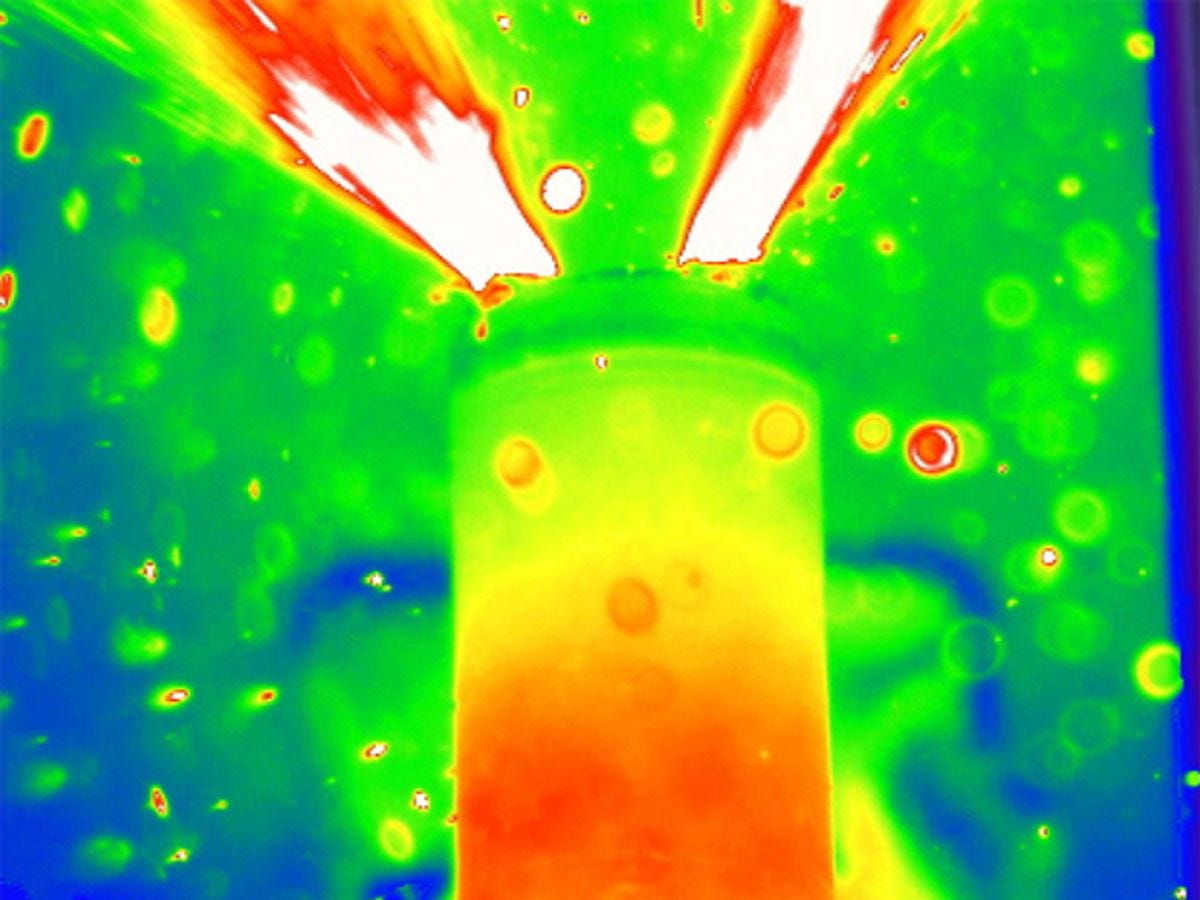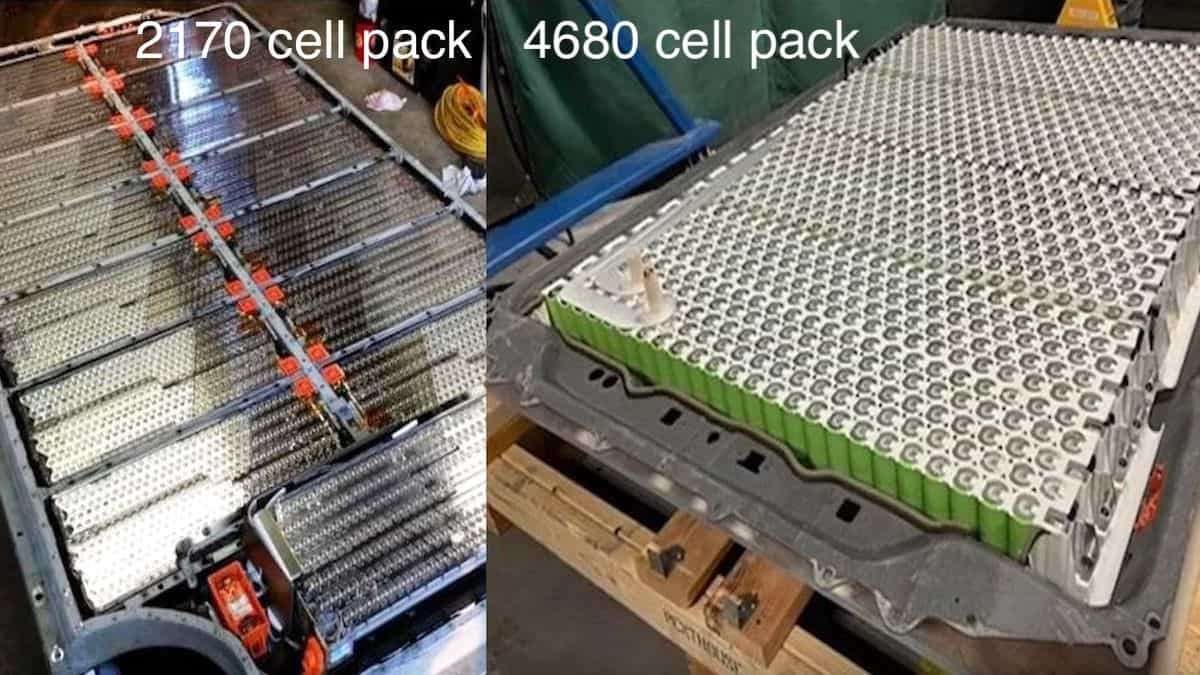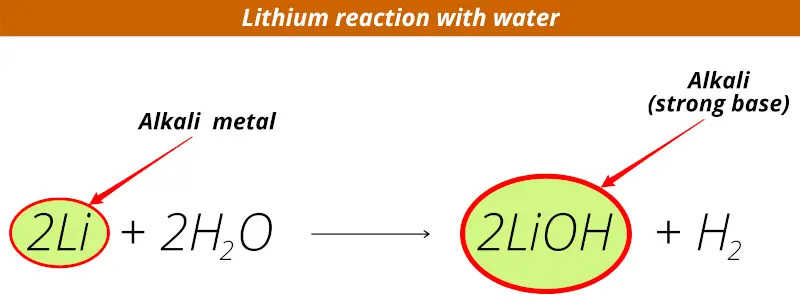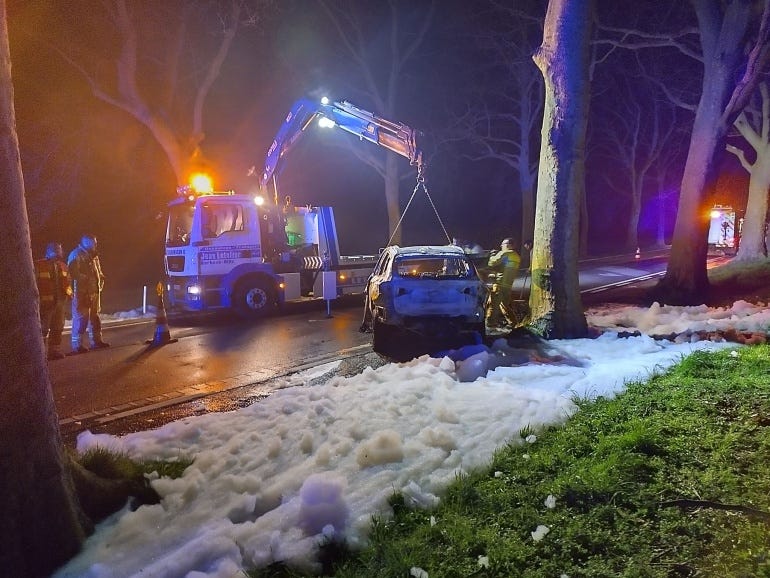EV Infernos: Torched Trailers, Tow Trucks, and Tow Yards
Industry Scorched by Spontaneous Combustion
Above: Ford F-150 Lightning lived up to it's name and caught fire on a car transport trailer, destroying both the trailer and innocent ICE vehicles.
Hello again Dear Readers! Welcome to another specially curated Cornucopia of EV Combustion Clusters. Like a multitude of prairie dog's heads popping up from the Dakota plains on a sunny day, the realms of possibilities for EViscerations have yet to be exhausted !
EV and E-bike battery fires have sunk cargo ships, burned down businesses and homes, and yet we are witnessing even more venues of destruction and frantic 911 calls.
Above: a fancy Porsche EV sent 4000 cars and the ‘ol Felicity Ace down to Davy Jones’ Locker. ‘Tis a pity so many cool ICE cars went down too.
Most of the media is underreporting these conflagrations, and say “don’t worry, EV and E-bike battery fires are rare”, and in our opinion, this is pure BS. This is because there are ever increasing numbers of EVs and E-bikes in congested cities and the ‘burbs, making the odds of having an incident even more frequent and more perilous.
Alarmingly, the co-opted green media also downplays the dangers EV and E-bike lithium batteries pose, especially in terms of catastrophic fires, such as those caused by battery impacts, punctures from accidents, and faulty charging. Also of major concern is the underreporting of the proliferation of low quality and counterfeit Chinese lithium batteries (not Taiwanese), which may lack circuit protection devices that prevent short circuits and thus fires.
Above: EVs and their battery packs should have circuit protection in case of over-current or over-voltage events. Many counterfeit batteries and backwater Chinese products leave out circuit protection to save money.
TC’s Sidebar: back in the day, your concierge chemist worked in the salt mines of the battery Circuit Protection Division of RayChem, which was eventually sold off to LittleFuse. Part of the work involved the analysis of Chinese counterfeit circuit protection devices for cell phones. It was found that they had no current shut-off functionality or circuit protection. Not so fun to have your face scorched by a lithium battery fire while on the phone, right? Overseas life is cheap apparently.
A lithium battery can fail and catch fire by catastrophic impact, puncture, poor quality of manufacture, or by faulty charging. In a properly functioning lithium battery, the electricity flow and battery chemistry are kept under control by a separation membrane and the battery case.
If a failure occurs, all bets are off and a cascade of chemical reactions may be suddenly unleashed without limits. This releases large amounts of heat in an uncontrollable fashion, and can lead to a physiochemical phenomenon known as a “self-propagating thermal runaway”, a catastrophic failure mode that feeds off itself like an ammo dump cooking off in the Sandbox.
Above: vicious cycle of lithium battery thermal runaway.
As one might imagine, a fire combined with thermal runaway is a bitch to extinguish. The propagating heat and flames ignite and reignite, consuming fuel materials from the battery itself and/or oxygen and moisture from the atmosphere, like a flamethrower working Tarawa pillboxes.
Above: lithium cell blow-out due to gas expansion and battery case failure during thermal runaway. From IEEE.
Molten Metal Volcanoes
It is important to note that an EV like a Tesla has a sh$t-ton of individual lithium cells (thousands), all densely connected together in battery packs to occupy as little space as possible.
Above: packing ‘em in - Tesla battery cell packs
When one or more of the battery cells are damaged or abused, the resulting heat can affect the battery cells adjacent to the first, causing a cascading failure mode. When the cells cook-off, an EV fire may burn as high as 5,000 degrees Fahrenheit (2,760 Celsius). In contrast, a gasoline-powered vehicle on fire burns at 1,500 F (815 C).
The high temperatures realized in a lithium battery fire can cause EV structural metals such as aluminum, iron, and copper to melt. Looking up the properties of metals used in an EV, one will find that the melting point of aluminum is 660 C, with copper at 1084 C, and steel at about 1425 - 1540 C. These metals may melt, pool, and/or vaporize in and around a lithium fire. In a typical scenario, a battery explosion from gas pocket ignition and failure of the battery case results in the high velocity ejection of hazardous molten metals, like volcanic lava being ejected from Mt. Vesuvius.
Above, run for the hills: thermal runaway and catastrophic failure of lithium battery cells.
As shown in the video above, lithium battery packs and cells can turn into blow torches as the fire feeds off flammable battery chemicals, such as organic liquid electrolytes and metal oxides. This is like a dragon farting fireballs. For more specific information see: The Ultimate Guide to Dragon Farts.
Yes, dear, there is even more to fear: another severe health hazard from an EV inferno is the plumes of carcinogenic gases comprising of benzene, miscellaneous polyaromatics, methyl-ethyl-bad sh*t, cyanide and other nasties generated from burning a plethora of interior and exterior plastics found in modern cars. Downwind is not the place to be. I would advise at this point: “run like hell and call 911”, before you are nailed by molten metal, and whatever you do, don't breathe the fumes!
Above: run nine-one-one, a Volkswagen ID3 spontaneously caught fire just after the driver put her child in the car and wanted to get behind the wheel herself.
Water Can Promote Lithium Battery Fires 🔥
Firefighters have a huge problem with EV fires in that they just can’t hose them down with water and expect to stop them. H2O chemically reacts with lithium to form flammable hydrogen gas and lithium hydroxide in what we chemists call an oxidation-reduction reaction, as graphically illustrated in the video below.
Above: a fun activity every person needs to try at least once is to throw a chunk of an alkali metal into water and see what happens! We used to do that in Beebe Lake in Ithaca (shhhh).
Alkali metals such as lithium, sodium and potassium burn (oxidize) underwater because they violently react with H20 molecules that “fuel” or promote the lithium oxidation. Water as a kind of “fuel” or promoter : when lithium comes in contact with H2O, it grabs the oxygen for itself (lithium is oxidized and gives up an electron) and converts the H2O hydrogen atoms into hydrogen gas (reduction of hydrogen). Hydrogen burns and explodes, so an EV fire can have characteristics not unlike the Hindenberg disaster.
Thrills and spills: chemical reaction of lithium metal with water form alkaline lithium hydroxide and hydrogen gas.
Special Containment Dumpsters and Pools for EV Thermal Runaway
In yet another twist in the world of EV thrills and toxic spills, Yankee Ingenuity comes into play so that firefighters are protected from thermal runaway and can contain an active or potential EV fire 🔥 by total submersion of an EV in water.
All you need to do is winch an EV into a presumably watertight EV fire containment “dumpster” or EV Firebox and flood with water. Nevermind the cost and transportation of the dumpster, taxpayers will surely subsidize. Another way to go is a portable EV submersion pool by Garrison, just the thing everyone in the business needs to keep handy.
Not to be outdone, our friends at Emergency One in the UK have come up with a upscale dumpster contraption called the “E1 – EV Submersion Unit”, as shown in the thrilling video below.
Above: super trick drive-in or winch-in EV fire containment dumpster from Emergency One.
Trailer, Tow Truck and Tow Yard Infernos: Talking to the Guys at the Tow Yard
I was visiting a tow yard outside Phoenix, Arizona when I inadvertently discovered a costly niche EV issue. I was there to inspect and recover items from a totaled car, (gratefully nobody was seriously injured in the wreck). It was nestled amongst other forlorn wrecks, each with their own unique story and trauma, and most notably a totaled VW ID4 EV. This VW had been segregated at the end of a line of cars for a reason.
Above: sad ID4 off by it’s lonesome
The workers and I were discussing some of the more interesting cars and crazy situations they had experienced, and the conversation transitioned to how lame EVs were, and the story behind the VW carcass.
The guys shared that the EVs and hybrids in the yard needed to be segregated from the other cars and surrounded by concrete EV containment barriers to protect the yard and adjacent cars from being incinerated should the EV’s spontaneously combust. This could be mysteriously triggered by some unknown gremlin, planetary alignment or just the hot sun.
Above: basically a concrete Lego, a tow yard EV Containment Protection Walling solution from Elite Precast Concrete.
The guys went on to share how the EV combustion albatross has increased their day to day running costs and insurance. It is expensive to purchase and move around concrete barriers just for the EV “customers”.
In an understandable rebellion, tow truck operators don't want to pick up EV wrecks because the EV or hybrid might light off while towing, and they are expensive to store if you do actually make it back to the yard. Indeed, in one case in AZ, an EV caught fire twice - once after hitting a building, and a second time while being towed!
Above: Arizona Tesla catches fire twice following crash.
In Europe, there are also reports of tow companies refusing to pick up EVs involved in an accident, as reported in Belgium: EV caught fire while driving - no local towing service wanted to deal with the wreck. Image below.
Above: after burning out, foam job and cool off, this wreck gets a lift in Belgium. Storage not allowed at the yard due to reignition concerns. Cars ultimate fate unknown.
In other situations, the results can be even more catastrophic for a tow or transport company because innocent and far more precious ICE vehicles get caught in the cross-fire 🔥 of an EV inferno, per one FL example shown below.
Above: tractor was able to ditch trailer just in time in FL.
Indeed, due to liability concerns, more and more EVs involved in accidents are being scrapped by insurance companies because of fears of battery failures and fires, as torched upon by Stu Turley in the article: EVs Head for Junkyard as Mechanic Shortage Inflates Repair Costs. Unfortunately, you never know when a wrecked EV is going to light-off and torch a tow yard, per video below.
Above: EV torches tow yard near San Diego, CA.
In yet another twist, hybrids with partially discharged batteries can wreak havoc on tow yards after sitting, as exposed in the video below by one of my favorite YouTubers, MGUY Australia.
Above: MGUY Australia details the results of an Aussie EV fire in a tow yard.
Cashing in on EV Liabilities and Hazards
In addition to the ambulance chasing parasite attorneys and insurance companies, a new industry has been spawned for risk analysis, hardware, and safety equipment such as EV containment barriers, portable EV submersion pools, EV submersion dumpsters, and battery isolation barriers (armor) for EV batteries.
All this makes life more complicated and a lot more expensive on truckers and the towing businesses, adding more hardships to regular working people having to deal with the virtual signaling of the more wealthy and the absurdities of this Ill-fated “transition”.
But the towing professional need not fear, as the Energy Security Agency has come to the rescue, providing a full guidebook and menu of bureaucratic liability options to service an EV inferno, per below:
Above: Ford F-150 Lightning strikes again!





















Excellent article; and to think our so-called leaders want to “improve” our power grid by essentially dismantling through not only wind but the radical idea of battery storage units. I’m confident that there is at least one or two instances in the world where one a battery storage unit caught fire and, you guessed it, was not able to be brought online to help with meeting power demand.
Excellent work, sir! Thank you! 😃
As opposed to the meme on Clean Technica. Of course there are many more ICE fires, there are many more ICE vehicles. What they don't understand is 90% of ICE car fires are small. A battery fire is tremendously destructive
Car Fires by Vehicle Type (meme) https://cleantechnica.com/2024/05/03/car-fires-by-vehicle-type-meme-2/